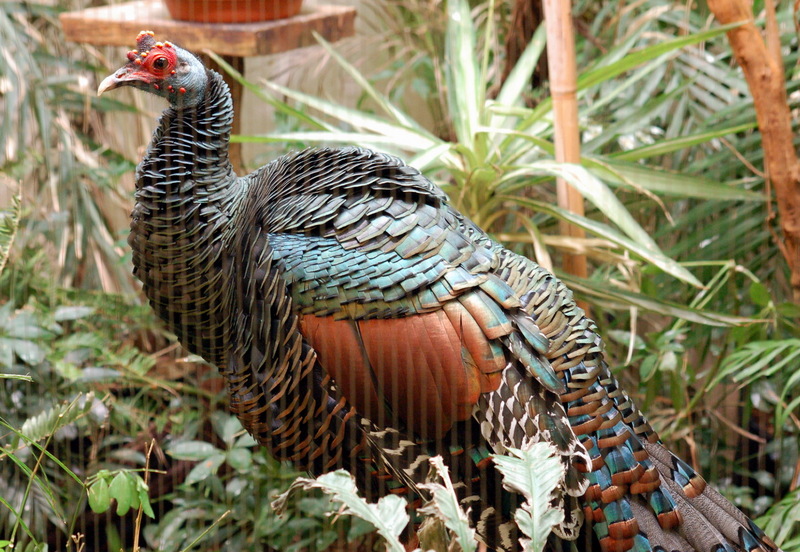| New Photos | Animal News | Animal Sounds | Animal Movies | Upload Photo | Copyright | Korean |
|---|
| Funny Animal Photos | Monsters in Animalia | Wiki Articles Fun Facts about Animals | Links | Home | Mobile A.P.A. |
|---|
| Image Info | Original File Name: Ocellated_Turkey_Meleagris_ocellata_National_Aviary.jpg Resolution: 1450x1000 File Size: 621804 Bytes Date: 2007:02:19 08:35:31 Camera: NIKON D50 (NIKON CORPORATION) F number: f/4.0 Exposure: 10/80 sec Focal Length: 860/10 Upload Time: 2007:11:22 13:26:44 | |
| Author | Name (E-mail): Unknown | |
| Subject | Ocellated Turkey (Meleagris ocellata) - Wiki | |
 |
| Email : E-Card | Poster | Web Master Delete Edit Info Admin |
| Description | Ocellated Turkey (Meleagris ocellata) - Wiki
Ocellated Turkey
The Ocellated Turkey (Meleagris ocellata) is a large bird, at around 70-100 cm (28-40 in) long and an average weight of 3 kg (6.6 lbs) in females and 5 kg (11 lbs) in males. In the past, it has sometimes been treated in a genus of its own, as Agriocharis ocellata, but the differences between this species and Meleagris gallopavo are too small to justify generic segregation. Range The Ocellated Turkey exists only in a 50,000 square mile range comprised of the Yucat??n Peninsula which includes the states of Quintana Roo, Campeche and Yucat??n, as well as parts of southern Tabasco and northeastern Chiapas. They also can be found in Belize and the northern part of Guatemala. Appearance The body feathers of both sexes are a mixture of bronze and green iridescent color. Although females can be duller with more green, the breast feathers do not generally differ and can not be used to determine sex. Neither sex have beards. Tail feathers of both sexes are bluish-grey with an eye-shaped, blue-bronze spot near the end with a bright gold tip. The spots, for which the Ocellated is named, lead some scientists to believe that the bird is more related to peafowl than to Wild Turkeys. The upper, major secondary wing coverts are rich iridescent copper. The primary and secondary wing feathers have similar barring to that of North American turkeys, but the secondaries have more white, especially around the edges. Both sexes have blue heads with some orange or red nodules, which are more pronounced on males. The males also have a fleshy blue crown covered with nodules, similar to those on the neck, behind the snood. During breeding season this crown swells up and becomes brighter and more pronounced in its yellow-orange color. The eye is surrounded by a ring of bright red skin, which is most visible on males during breeding season. The legs are deep red and are shorter and thinner than on North American turkeys. Males over one year old have spurs on the legs that average 1.5 inches, which lengths of over 2 inches being recorded. These spurs are much longer and thinner than on North American turkeys. Ocellated Turkeys are much smaller than any of the subspecies of North American Wild Turkey, with adult hens weighing in at about 8 pounds before laying eggs and 6-7 pounds the rest of the year, and adult males weighing about 11-12 pounds during breeding season. Behavior Turkeys spend most of the time on the ground and often prefer to run to escape danger through the day rather than fly, though they can fly swiftly and powerfully for short distances as the majority of birds in this order do in necessity. Roosting is usually high in trees away from night hunting predators such as Jaguars and usually in a family group. Female Ocellated Turkeys lay 8-15 eggs in a well concealed nest on the ground. She incubates the eggs for 28 days. The young are precocial and able to leave the nest after one night. They then follow their mother until they reach young adulthood when they begin to range though often re-grouping to roost. The voice is similar to the northern species too, the male making the "Gobbling" sound during the breeding season, while the female bird makes a "clucking" sound. Branton and Berryhill (2007) have observed that the male ocellated turkey does not gobble per se as does each of the other turkeys that comprise the World Slam. Rather, his song is distinct and includes some six to seven bongo-like bass tones which quicken in both cadence and volume until a crescendo is reached whereupon the bird’s head is fully erect while he issues forth a rather high-pitched but melodious series of chops. The ocellated turkey will typically begin his singing 20 to 25 minutes before actual sunrise ??? roughly analogous to (the) Mississippi Eastern sub-species of the wild turkey. http://en.wikipedia.org/wiki/Ocellated_Turkey
| |||
| Copyright Info | AnimmalPicturesArchive.com does not have the copyright for this image. This photograph or artwork is copyright by the photographer or the original artist. If you are to use this photograph, please contact the copyright owner or the poster. |
|
|
|
| |||||||
| CopyLeft © since 1995, Animal Pictures Archive. All rights may be reserved. | ||||||||
Stats